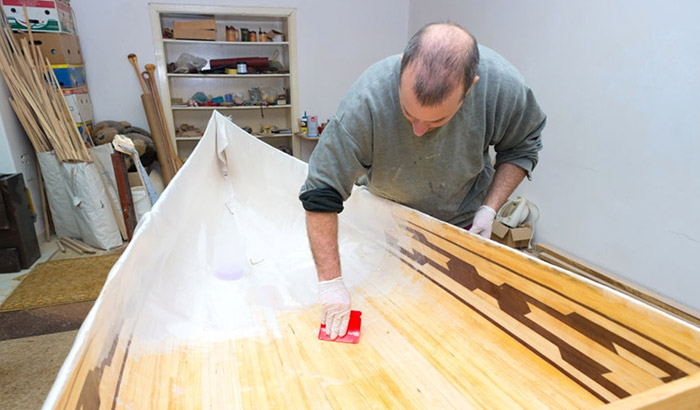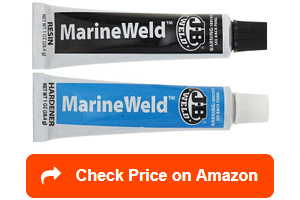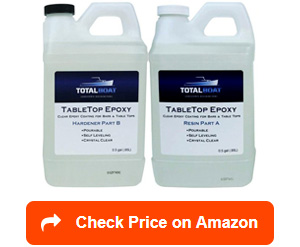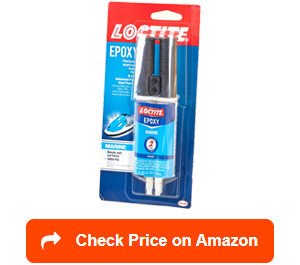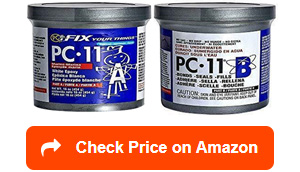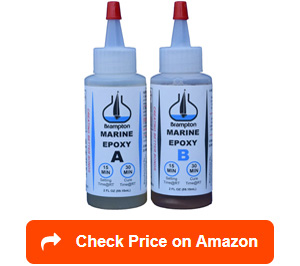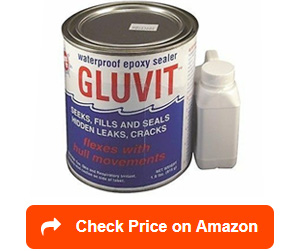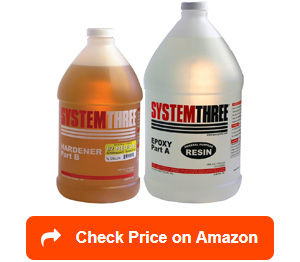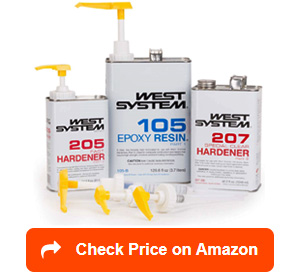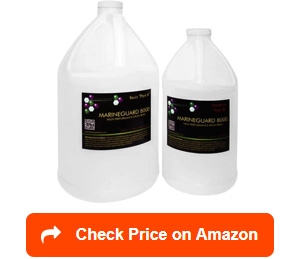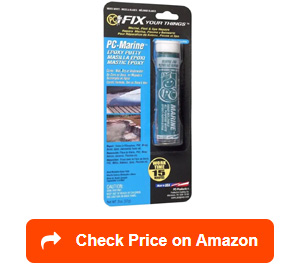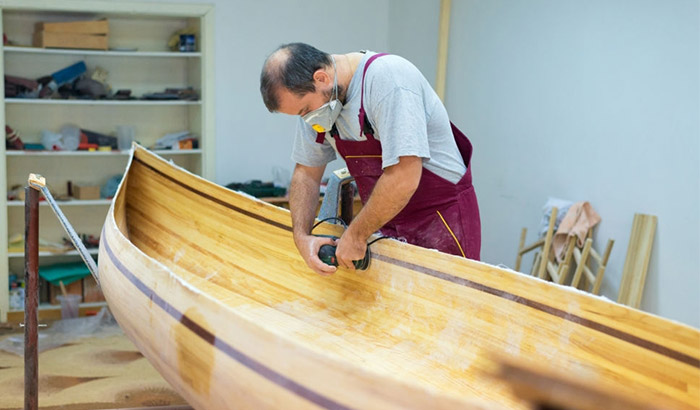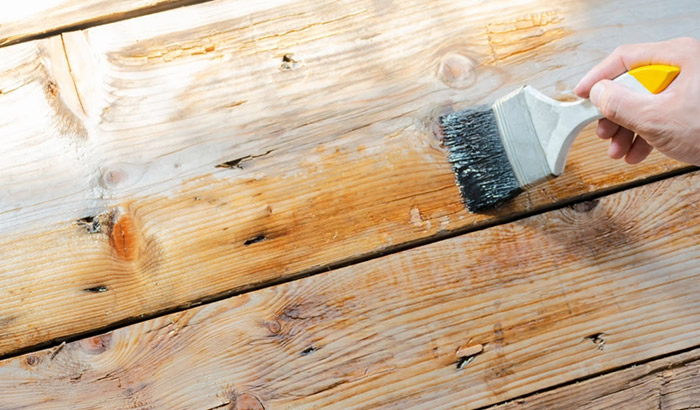There is no telling when your boat will suffer from damage that will need immediate repairs. During those times, you need to have the best marine epoxy on standby. It is a multi-purpose adhesive, which may just be the thing that would save you and your boat from even more costly repairs in the long term.
Marine epoxy is like the resin-based epoxies that you commonly used for household repairs. However, this product is more suitable during those times when you need something stronger than superglue to hold things together.
The difference between regular and marine epoxy is that epoxy resin for boat building offers a stronger and more permanent bond. It can also resist the corrosive effects of saltwater.
Since there are so many different brands that offer marine epoxies, finding the best one for your needs will be challenging. Fortunately, this article will teach you the things that you need to look for in this specific product, so you will not waste your time and money on an inferior marine epoxy.
Contents
- Best Marine Epoxy Reviews
- 1. J-B Weld 8272 MarineWeld Marine Epoxy
- 2. TotalBoat Resin Crystal Epoxy Coating
- 3. Loctite 1919324 Marine Epoxy
- 4. PC-Products PC-11 Epoxy Adhesive Paste
- 5. Brampton Marine Epoxy
- 6. Travaco Marine-Tex RM330K Gluvit Epoxy Sealer
- 7. System Three 0102K46 Epoxy
- 8. WEST SYSTEM 105-B Epoxy Resin
- 9. MARINEGUARD 8000 Epoxy
- 10. PC Products PC-Marine Epoxy Putty
- Who is This for?
- Features to Consider When Buying Marine Epoxy
- Advantages and Disadvantages of Using Marine Epoxy
- Care and Maintenance
- Frequently Asked Questions
- Conclusion
Best Marine Epoxy Reviews
1. J-B Weld 8272 MarineWeld Marine Epoxy
This product is one of the strongest epoxies that I have ever had the pleasure of using. Once fully cured, this epoxy can withstand more than 5,000 psi of force, which makes it a permanent bond. Anything that you stick together with this epoxy will never come apart undamaged.
Another nice thing about it is that it can bond non-porous materials, like metals, plastics, laminates, and such. With that, I can say that it is indeed a great choice for boat repairs, as most of the components are non-porous.
I used it to make a small patch on the hull of my fishing boat, on a part that sometimes gets below the waterline. I noticed that it is still holding solidly today.
As mentioned previously, this product is a marine epoxy, which means it can withstand the corrosive effects brought about by seawater. Even though this resin epoxy is steel-reinforced, it will not break down or corrode when exposed to saltwater.
In fact, it can also withstand chemicals and certain acids. This product is, therefore, the perfect choice for fishing vessels as it can stand up against the horrible conditions of the sea.
This stuff is also great for filling up dents on the hull of boats, or even on a car. Although it is not as user-friendly as regular epoxy filler, it will do for small dents. Another nice touch is that once this epoxy cures, you can sand it down so that it is level with the surrounding surface.
I only wished that this epoxy would dry and cure faster. As it is, it takes a day or two to dry, and an additional week for it to cure. You would not want to use this product if you are in a hurry to fix something. You need to be more patient to reap its benefits.
- Has incredible tensile strength
- Can bond non-porous surfaces together
- Can be sanded, molded, and even drilled
- Withstands saltwater, chemicals, and even acids
- Completely waterproof once fully cured
- Takes a long time to set and cure
Although this epoxy takes a while to harden, it is one of those times when a little bit of patience will give you a whole lot of benefits. You can pretty much permanently bond two surfaces together, so it is worth the wait.
2. TotalBoat Resin Crystal Epoxy Coating
This epoxy resin for boat repair is the ideal choice for giving your projects a nice-looking and high-gloss surface. I used this epoxy on a coffee table I was working on, and once it dried and cured, the epoxy left a deep and glossy finish. It looks like the wood is beneath a thin pane of clear glass but it can withstand multiple blows from a hammer.
This product is a 1:1 ratio epoxy, meaning you need to mix equal parts of the resin and hardener to activate it. You do not need to make complicated calculations, so you can easily mix whatever amount you need. I find it best to use a hand pump so that mixing up small batches becomes a lot easier.
Once cured and dried, the epoxy becomes extremely durable. It is the ideal product to use when planning to give kitchen counters a deep and clear shine. Even if you drop your kitchen utensils and other stuff, the surface will neither chip nor show any scratches. If you scuff the surface, just wet sand it, and the marks will disappear.
I am also happy that it can bond onto many different materials. I have already tried using it on wood, metal, and concrete. I also used this product to make all sorts of things on my lathe. Once dried and cured, the block of resin becomes solid enough to turn on a lathe without shattering.
The only problem that I have with this product is that it has a somewhat fast working time. You will need to pour this epoxy resin within 20 minutes of mixing or else it would get too thick and will not pour evenly.
- Dries clearly and with high gloss
- Easy to use and pours smoothly
- Durable and resistant to scratches and other damage
- Can work on many different materials
- Ideal for use on various projects
- Has a rather short working time
Whether it is for crafts projects or finishing tables, countertops, and other flat surfaces, you will like using this versatile epoxy resin.
3. Loctite 1919324 Marine Epoxy
The thing that I liked a lot about the Loctite marine epoxy is that it comes in a two-barreled syringe. With that, you can get equal amounts of epoxy and hardener. All you need to do next is mix and apply the epoxy. No need to guesstimate the amount of each part. Just push the plunger and you are all set.
This epoxy is also waterproof, making it ideal for repairing boats and other watercraft. Moreover, you can apply this epoxy underwater. It will continue to harden and cure even when left submerged in water. You would do well to have a tube of it in your boat’s toolbox.
Once hardened and completely cured, you can easily shape, sand, and even drill through this resin epoxy without it shattering or cracking. You can also use it as a body filler for small dents and cracks on your car’s body or the hull of your boat. Just sand and paint over it and it will look like new.
This product is also a marine epoxy, so it can easily resist the corrosive effects of saltwater. Even light solvents will not leave a mark on it once cured. If you have a boat that you often take out to sea, any repairs you do with this product will be more or less permanent.
This product would have gotten higher marks from me if only Loctite provided even a small pallet and applicator in the package. If you need to fix something quick, having an applicator on the ready would help a lot.
- Comes in a convenient syringe packaging
- Resistant to water and most solvents
- Will not chip or crack when drilled
- Can cure completely even when left underwater
- Does not shrink
- You need to provide your own applicator
Even though the issue about the applicator, or lack thereof, can be annoying, there is no denying that this epoxy works well and should be a staple in anyone’s toolboxes.
4. PC-Products PC-11 Epoxy Adhesive Paste
This product is one of the most ideal marine epoxy coatings I have ever used. It works well especially if you intend to make emergency repairs on your boat while you are still on the water.
Of course, it is ideal to dry dock your boat first when doing repairs, but there are times when you must do them on the spot; otherwise, there will be extensive damages later. Even if the damaged part is under the waterline, you can use PC Products epoxy to patch it up quickly and effectively.
Another thing that I liked about this epoxy is that it is usable on almost all materials that you can think of. I have used it to reattach broken floor and wall tiles, and it adhered so well onto the concrete that I doubt if anything short of an earthquake can dislodge them now. It also works on non-porous materials, like glass, metal, plastics, and laminates.
This two-part marine epoxy gets so tacky and thick that applying it onto a vertical and overhead surface is easy. You do not need to worry about it dripping down and getting all over the place. Therefore, it is the ideal product for boat hull repairs. It is so thick and tacky that you will need to try to mess up the application process.
Although it is a given that marine epoxies like this one should be resistant to saltwater, it is also highly resistant to caustic chemicals. This product can withstand corrosion dealt with by gasoline, some mild acids, and strong detergents. It is the type of epoxy that you can just forget about once used.
With that said, you might find it very difficult to use this epoxy on small, delicate repairs. For instance, reattaching the broken handle on your favorite coffee mug can be a bit tricky because this epoxy is thick and tacky and making small batches gives you such a very short working time.
- Usable on dry, wet, and even submerged surfaces
- Can adhere and bond to many different surfaces and materials
- Tacky consistency, promoting ease in application on vertical and overhead surfaces
- Highly resistant to saltwater and several caustic chemicals
- Has a very wide service temperature range
- Not for delicate repairs as it may get too messy
Although this epoxy is not meant for delicate repairs, you can still do a lot of other repair jobs by just using it.
5. Brampton Marine Epoxy
What will you do when your boat springs a small leak? Continue your trip and hope for the best? A small leak can lead to even bigger problems later, thankfully there is Brampton marine epoxy, a heavy-duty epoxy that you can even apply underwater, so you can fix any damage immediately.
One incredible fact about this product is that it is highly resistant to most solvents and caustic chemicals. If you accidentally spill gasoline over the repaired surface, it would do nothing to negatively affect the epoxy. This stuff is so tough that not even bleach or mild acids can leave a mark on the surface.
It is also extremely weather-resistant; neither rain, snow, or extreme temperatures can harm this epoxy. It can also create an airtight and watertight seal, so if you need to plug a sizable hole in your boat’s hull, then it is the product that you need.
The best part is that you can use it to plug up holes that are under the waterline. It will harden and cure even when submerged underwater.
Speaking of curing, you need to apply this epoxy as quickly as you can as it will start to set after just 15 minutes, and it will harden and cure completely in 30 minutes. It came in handy when I needed to reattach the handle of one of my hand tools. The epoxy set and hardened so quickly that I didn’t even lose a beat while working.
However, its fast-curing time can also work against you. I suggest that you mix epoxy in small batches as it will immediately start hardening after a minute or so, making it quite difficult to apply.
- Ideal for use underwater
- Resistant to most solvents
- Dries in 15 minutes and completely cures in 30 minutes
- Weather-resistant and waterproof
- Comes in a squeeze bottle for easier dispensing
- Very short working time
This epoxy checks all the boxes that describe a good quality adhesive. It hardens quickly and bonds on almost all surfaces while also being easy to use. There is no reason why you should not at least give this product a try.
6. Travaco Marine-Tex RM330K Gluvit Epoxy Sealer
Unlike the kind of epoxy that you use to fix cracks and other kinds of damage, this one is quite a bit runnier. You can also apply it like paint. I used this product to cover the entire hull of my 20-year-old aluminum boat and it covered all of the tiny holes perfectly. It made my ancient boat look and feel like new once again.
Speaking of covering an entire boat, this marine epoxy paint fiberglass kit has more than enough to cover the bottom and transom of a 14-foot boat. The last time I used it on my boat, I had enough left over to seal a wooden stool that I made in my woodshop. You can also use it for other purposes, like workbenches, kitchen counters, and the like.
This product is also easy to use. There is enough space in the tin of the resin for you to pour the entire contents of the activator bottle. It means there is no need to transfer the contents into a separate mixing container. Also, all you need to apply this product evenly over a surface is a good quality roller brush.
If you do not want the clear and glossy finish left by this epoxy sealer, you are in luck because you can sand and paint over it once cured completely. Unless you are sanding down the high points of the epoxy layer, all you need to do is scuff it up a bit so that the paint will have a better grip on the surface.
Now, if you want to leave the clear epoxy coat the way it is, know that it is not completely colorless. Once dried and cured, the epoxy sealer has a slight tinge of brown. It will not be that noticeable when applied on a dark surface, but if you lay it on a lighter-toned base, you will notice that the finish is a bit darker.
- Completely seals the surface where you apply it to
- Has more than enough content to cover the hull completely
- Easy to use
- Dries and cures quickly
- Very sandable and paintable
- It does not dry completely clear – It usually comes with a slightly brownish tinge.
Despite being not completely colorless, which would not matter if you are covering the underside of an old boat, it is still quite a top-notch product. This is especially true if you are going to use marine epoxy paints over it anyway. The important thing is that it can provide a good seal and repairs even the tiniest of holes.
7. System Three 0102K46 Epoxy
I like to do my part to help the environment whenever I can, which is why I chose to use this epoxy resin. The System Three resin epoxy contains a significant amount of renewable materials, making it more eco-friendly compared to the other similar products available in the market today.
This resin epoxy product is also easy to use. You just need to follow a simple formula for mixing resin, which is 2 parts resin to 1 part hardener. It is the reason why I highly recommend using a hand pump to make mixing up batches of resin much easier. I only use measuring cups when working on big projects.
Once mixed, you have around thirty minutes before the mixture starts getting a bit tacky, which is already a good amount of time. It works great when you are working on a big project, like a resin waterfall table, where you need to make large batches of resin. You will be glad that you have such a long working time.
Another thing that I liked about this product is that it has such a low viscosity even after combining parts A and B. It promotes ease in pouring over the surface that you are working on and it will spread out evenly. I also liked how this resin does not develop that many bubbles. I hardly ever use my heat gun to get rid of bubbles anymore.
Now, I do have a bit of an issue with this product, and that is the drying and curing times stated on the labels are very far from the truth. Even if you follow the mixing instructions exactly, it will still take more than 24 hours before the resin epoxy dries completely, let alone cure.
- Contains a significant amount of renewable materials
- Has a thirty-minute working time
- Easy 2:1 mixing ratio
- Works on many different material surfaces
- Low viscosity, which also means an easier application
- Takes a long time to dry and cure
Now, this product would have gotten higher marks from me if the drying and curing times were a bit shorter. However, considering that I have constantly found success when using this product, I do not think that I would take it out of my regular tool rotation.
8. WEST SYSTEM 105-B Epoxy Resin
You will need to mix West system epoxy resins using a 5:1 epoxy to hardener ratio, which can be hard to measure. It is the reason why it is so convenient that this kit comes with calibrated pumps that dispense an exact amount every time. One pump of the will always be five times more than that of the hardener, so no need to keep count.
This product also has an average working time of around 9-12 minutes, which is a reasonable amount of time to mix and pour the resin epoxy onto the surface or mold. You will have a reasonable amount of time before the resin starts to get tacky and unworkable.
After the working time of 12 minutes, the West systems marine epoxy will quickly dry and lose its tackiness. After around 10 minutes of application, the surface will be relatively dry, at which point, you can start to pour another layer of resin on top if you need to. The product will cure completely after 4 days.
I also liked how it will bond onto almost all kinds of surfaces. I have made a couple of projects where I had to work with metal and wood, and so far, I have not had any trouble making the epoxy adhere to any surface I have worked with. I have heard that other makers have successfully used this resin on other materials like plastics.
The only problem I have is not with the product itself, but rather with the pumps that came with the kit. You need to be careful when using the pumps as they are quite fragile. The calibrated pump for the resin is particularly easy to break. If you don’t have the convenience of using a pump, you will need to carefully measure the resin and hardener.
- Comes with calibrated pumps
- Has a very reasonable working time
- Dries and cures quickly
- Can bond onto different kinds of material surfaces
- Has a myriad of different uses
- You need to be extra careful with the pumps as it is prone to breakage.
Although, unfortunately, the pumps break rather easily, the product itself is top-notch in my opinion. I have yet to encounter any serious problems with this resin epoxy, which means it is good and I highly recommend it.
9. MARINEGUARD 8000 Epoxy
The thing that I liked the most about this product is that it came with hand pumps for easier and more accurate dispensing. No need to measure the amounts using a graduated cup. You just need to count the number of pumps you made.
The pumps are calibrated so that you just need to make the same number of pumps from the resin and the hardener and it will give you an exact 2:1 ratio every time.
I managed to use this resin epoxy, not just for sealing the underside of my rather ancient boat. I also used it on a couple of woodworking projects of mine, like a resin river coffee table, and it came out looking great.
The resin was quite easy to tint different colors. I also heard good things about turning this resin on lathes. It does not easily chip or crack, making it the ideal material for turning on a lathe.
Once completely cured, this product becomes highly resistant to saltwater, harsh detergents, and even some mild acids. It means that you can use this product even on the hulls of the boat that are below the waterline. I used it to cover the underside of my decades-old canoe and it managed to cover all the leaks.
I also highly recommend it for use on other materials, like aluminum, smooth concrete, and other non-porous materials. You can use it to repair fiberglass, but you need to use fiberglass fabric for patch-up jobs, and epoxy paint for fiberglass boats for covering up the damage. It helped refinish our concrete kitchen counter and it looked nice.
The drawback here is that it takes a while to dry and cure. After a full day, the resin was still tacky. It took almost a week to cure the product completely.
- Easy to use, comes with a handy calibrated pump
- Resistant to chemicals, including mild acids
- Resistant to saltwater and UV rays
- Bonds onto different kinds of material surfaces
- Ideal for use on many different projects
- Takes quite a long time to dry and cure
Even though the resin took quite a long time to dry, the resulting finish was more than I hoped for. I was very clear and so smooth that I did not even need to polish it. If you are thinking of doing any project resin-related, you would do well to use this product.
10. PC Products PC-Marine Epoxy Putty
When you are out on the water on your small paddle boat, and it sprung a leak, you need to reach out for the PC Products marine epoxy. I found myself in a similar situation, and this product was literally a lifesaver.
It is great that you do not need any tools when using this. I just broke off a bit of the putty, mixed it up using my hands, and slapped it onto the leak, and it was gone.
As mentioned earlier, this marine epoxy putty can stick even on wet surfaces. There is no need to prepare the surface, which is especially good when you need to make emergency repairs. I also used it to fix a leaking kitchen sink drain pipe.
It is moldable to any shape. With that, I also found use on it when the need to repair a broken vase arose. I just molded a bit of putty into the new handle and fixed the problem.
It truly helped that this product has a work time of up to 30 minutes, which was more than enough time for me to fashion a replacement part. I also used this product, as an experiment, to create fantasy miniatures. It gave me enough time to properly sculpt the major details I needed before the putty started to harden.
As mentioned, this putty epoxy can adhere to wet surfaces, but it can also stick to metal, marble, glass, and even certain plastics. Unlike other products where you need to completely clean the surface, this epoxy does not even care if there is a bit of dirt. You can still expect it to stick.
The only issue that I have is that it is difficult to get it off your hands. This putty can get tacky if you mix it too long. Even kerosene had a hard time removing the putty. I would have normally used rubber gloves when handling this, but it is hard to find rubber gloves in an emergency.
- Easy to use – It is hand-moldable and does not require the use of any additional tools.
- Can adhere to wet surfaces
- Provides a reasonable work time, cures in an hour
- Bonds to various surfaces
- The perfect emergency repair tool for boats
- Hard to wash off hands, so it is highly recommended to wear gloves
In hindsight, having a UV-resistant marine-grade epoxy resin that is difficult to wash off is a good thing. This means that it will stick onto the surface securely and it will not come off that easily. This epoxy is an essential tool that you should always have within your reach. Just make sure to wear rubber gloves when using them.
Who is This for?
Marine epoxies are generally for boat repairs, namely boats that go out to sea. You will find these products useful in patching up cracks and holes on the hull. Once they get dry completely, you can expect them to turn into a solid plastic patch that is very difficult to remove.
However, you do not necessarily need to be a boat owner to find uses for marine epoxy. This adhesive has many different household applications, too. You can even use it to repair broken tiles, leaking plumbing, broken china, and a lot of other stuff. With that, it is advisable to have at least a small tube of the stuff in your toolbox at home.
Features to Consider When Buying Marine Epoxy
What are you going to look for when shopping for a high-quality marine epoxy? The following are just some key features and factors to keep in mind:
Working Time
The working time here refers to the amount of time required for you to apply the epoxy after mixing the two parts of the product together. Ideally, you should get an epoxy with around 10 or more minutes of working time. It is especially true if you have a large project on your hands and you need to mix a large batch of the product.
The Right Type for a Particular Job
If you will only be working on a small repair job, it is best to get a marine epoxy that comes in small tubes. If you do not have any other projects lined up, the epoxy would just dry up over time.
Also, you will need to get an adhesive that could adhere to the material that you will be repairing. For instance, you can’t expect all epoxies to adhere to PVC plastics, so you will only be wasting your time and money using the wrong kind of epoxy.
Drying and Curing Time
The drying time refers to how long after application will the epoxy become dry to the touch and not tacky. The curing time, on the other hand, is the amount of time when the epoxy will reach its maximum strength and hardness. Depending on the product, it could be anywhere between a couple of hours to days.
What makes most marine epoxies unique is that they can continue curing even when submerged underwater. Since these adhesives are usually for boats, they need to have this feature so that the vessels are not grounded for days.
Ease of Use
All epoxies require you to combine two ingredients – the resin and the hardener – in somewhat equal amounts. Some epoxies require a 1:1 ratio of epoxy and hardener before they can start curing. However, you can find others that need 2:1. There are even those that require 5:1, making them a bit more complicated to mix.
However, there are those so-called putty epoxies that look like modeling clay. The outside of this product is the epoxy and rolled inside the tube is the hardener, so you just mash the hardener into the epoxy to start the curing process. It is the most convenient epoxy to use, but it is good for making small and detailed repair work.
Viscosity
This factor is important if you are shopping for an epoxy resin sealant because it is the type that you need to pour over a surface. This epoxy needs to be viscous so that it can spread out evenly and cover all of the holes that cause leaking, even the ones that you cannot see.
On the other hand, if you will be using the epoxy resin for craft purposes, like making paperweights, or if you want to cast objects inside resin, then you would want to use an epoxy resin that is a bit thicker so that it will set faster.
Adhesion
This feature refers to the ability of epoxy to stick onto different materials. You need to know this because you may accidentally get an epoxy that cannot even stick onto the surface you are repairing.
Although most epoxies can stick to almost all non-porous surfaces, it is still possible for them to have a hard time adhering to certain surfaces. Some examples would be fiberglass and some plastics.
Mold and Mildew Resistance
It will be especially important if the object that you are repairing will be in or around water. If the epoxy does little to prevent mold and mildew from attaching to it, then it would only cause even more serious damage than the one that it is supposed to repair.
Strength and Durability
The strength of an epoxy refers to the amount of force that it can handle before it fails. For instance, a good quality, steel-reinforced, epoxy can hold upwards of a thousand pounds of pressure before it will crack.
A good epoxy can also handle a couple of blows from a 10-pound sledgehammer and it would nary leave a mark on the surface.
Paintability
No one would like to have a very visible epoxy patch on the side of their boat or car, which is why you need to get an epoxy that can be sanded down and painted over so that it would not be quite as visible. If you have experience with vehicle painting and body repair, you can make it look like nothing happened.
Versatility
Almost all marine epoxies have multiple uses. However, you need to be careful because you might accidentally get a kit for epoxy resin sealant, which has an entirely different set of uses.
You will be using sealant when you need to cover a wide area with a thin coat of epoxy resin. It will plug up even the tiniest of leaks. It is commonly used for coating the entire hull of small water vessels, and it is not good when used as an adhesive because it is thin and takes a long time to dry.
Advantages and Disadvantages of Using Marine Epoxy
Advantages
So what are the positive benefits of using marine epoxy? Here are just a few of them:
Proven strong and durable
The bond strength of epoxy adhesives is comparable to welded joints. It will take a crazy amount of force to pry away two pieces bonded together using epoxy. Even marine-grade epoxy paint is more resistant to damage compared to regular paints.
Prevents Further Damage
In the instance of epoxy marine sealants, it can prolong the life of the boat it repairs, and in many instances, it can bring an out-of-commission boat back to life.
For instance, it is easy to fix an old aluminum boat with dozens of tiny holes just by pouring a good amount of marine epoxy sealant all over the bottom.
Can Bond Onto Non-Porous Surfaces
Unlike regular glue, marine epoxy will have no problem sticking onto glass, metal, and other non-porous surfaces. It is the reason why many boat owners also use epoxy for mounting accessories onto the deck of their boats.
Highly Resistant to Corrosive Elements
Unlike other adhesives, epoxies are more resilient and resistant to weathering, UV rays, chemicals, detergents, and other substances that could damage and cause them to loosen their hold. Unless you use extreme blunt force, you will not be able to remove epoxy once it is set.
Disadvantages
However, this product also carries some disadvantages – among them are the following:
Requires Time for Preparation
To activate the epoxy adhesive, you will need to combine the two parts of the product and follow a specific formula. Most epoxies follow a 1:1 ratio, meaning you need to combine 1 part of resin to 1 part of activator/adhesive. However, some require a 5:1 ratio, which can be a bit harder to measure.
Not Suitable for Small Repairs
If you need to do some precise repair work, you should just use superglue. Marine epoxy, although strong, is hard to apply with precision. Fixing a mug handle using epoxy is possible, but using it to reattach a small chip that fell off the same mug would leave a huge bump on the surface.
Does not Set Immediately
If you need to connect two broken parts together immediately, you need to use superglue instead of epoxy. The reason is that epoxy will need some time to set. Some even require half an hour to a couple of hours to dry and cure.
Care and Maintenance
The nice thing about marine epoxy adhesives is that they are pretty much low to no maintenance once dry and cured properly. However, there are a couple of things that you can do to prevent epoxies from deteriorating.
As much as possible, do not expose the epoxy to too much sunlight. Although epoxies are already highly resistant to UV rays, it is always better to not purposely expose them to the rays of the sun.
It is also advisable to clean the epoxy patches often. Do not let dirt and debris settle on top of the epoxy for extended periods. Lightly scrub the surface of the epoxy using a soft-bristled brush or sponge to remove any dirt that is on the surface. Also, do not use a detergent that is too caustic as it can cause the epoxy to dry and become brittle.
Also, do not use acidic cleansers, including vinegar or citrus-based products. Yes, epoxy is resistant to acids, but it is not good to expose it to them knowingly. Accidental spills should be okay, but saturating it in acid and allowing it to sit, will cause a bit of damage.
If you have a lot of leftover epoxies, make sure that you keep the caps screwed on tightly and keep the two epoxy components separate from each other. Also, keep the containers in a place that is dark and dry to keep them from curing. However, you should not keep epoxy in storage for too long. Use it within a couple of months or else it will start to cure.
Frequently Asked Questions
How Long does Marine Epoxy Last?
Epoxy, once properly cured can last virtually forever. Officially though, epoxy manufacturers claim that their products can last for at least 30 years. You can expect your epoxy repair job or project to last forever if taken care of properly.
Can you Paint Over Marine Epoxy?
Yes, once marine epoxy has dried and cured enough, you can sand over it to make the surface smooth and even. You can then paint over it like normal using marine epoxy spray paint. Epoxy dries and hardens into a solid resin block, which is pretty much a plastic slab. Just scuff the surface up so the paint can adhere to it properly.
On the other hand, if you will be using an epoxy sealant, you can tint it to whatever color you like before you pour it over the surface you would like to treat. This way, you would not have to paint over it anymore.
What is the Difference Between Marine Epoxy and Other Epoxies?
Marine epoxy’s formulation allows it to resist the corrosive effects of saltwater and other substances. With that in mind, you can expect this type to be the ideal choice for repairing boats, especially the ones that go out to sea.
Another difference between marine and regular epoxy is that marine epoxy is many times stronger and more resilient against damage. It is expected that marine epoxy will encounter more situations that can cause extensive damage, which is why manufacturers reinforce the formulation to make the product stronger.
Conclusion
Having the best marine epoxy means that you will always have the best implement on hand whenever you need to make repairs that are strong and permanent. A good epoxy will not only fix the damage but also reinforce it and make it more durable than before.
The problem is that there are so many different marine epoxy resin suppliers that offer the same kind of product. Fortunately, you have reached this point of the article, which means that you have already learned everything that you will need so you can make the right choice.

